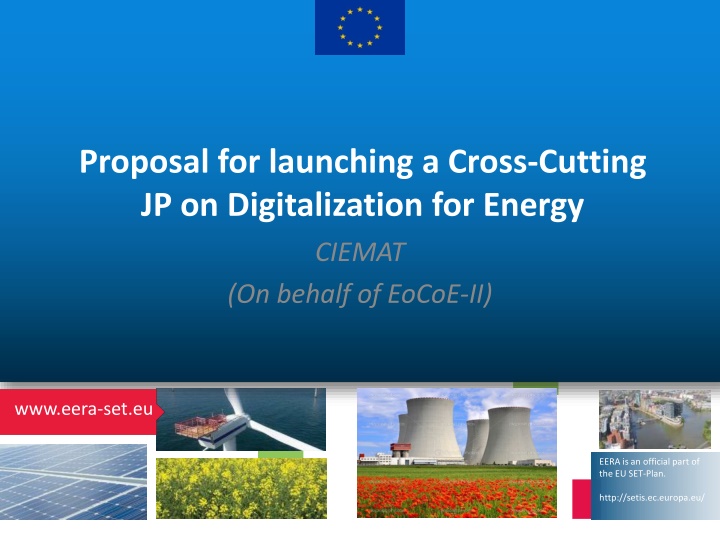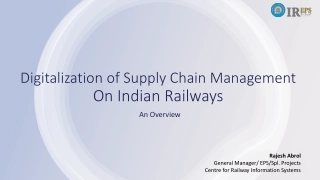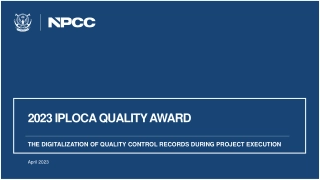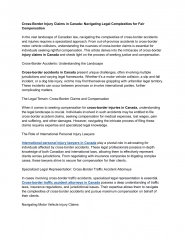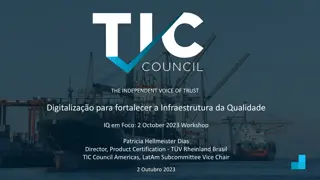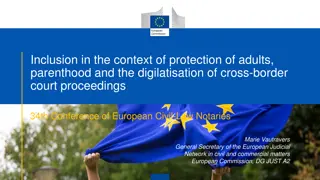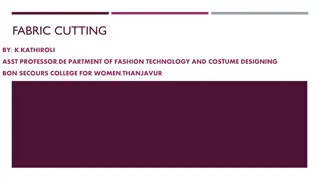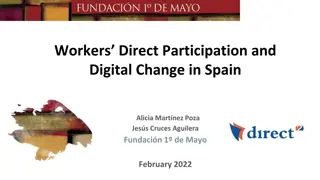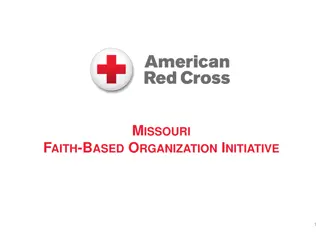Proposal for launching a Cross-Cutting JP on Digitalization for Energy
Leveraging existing cross-cutting knowledge in EERA to create synergies and develop a sustainable framework for collaboration among different Joint Programs.
Download Presentation

Please find below an Image/Link to download the presentation.
The content on the website is provided AS IS for your information and personal use only. It may not be sold, licensed, or shared on other websites without obtaining consent from the author.If you encounter any issues during the download, it is possible that the publisher has removed the file from their server.
You are allowed to download the files provided on this website for personal or commercial use, subject to the condition that they are used lawfully. All files are the property of their respective owners.
The content on the website is provided AS IS for your information and personal use only. It may not be sold, licensed, or shared on other websites without obtaining consent from the author.
E N D
Presentation Transcript
Proposal for launching a Cross-Cutting JP on Digitalization for Energy CIEMAT (On behalf of EoCoE-II) www.eera-set.eu EERA is an official part of the EU SET-Plan. http://setis.ec.europa.eu/
Context 2019 Summer Strategic Meeting in Espoo final report SSM Report - Topic 2: Cross-cutting topics - Suggested actions 2.1 Leverage on existing cross-cutting knowledge in EERA and implement a corresponding framework Many JPs have topics reflected in their structure that offer connection points with other JPs. In addition, participants in JPs also often have expertise in other domains that are not reflected in their particular JP, and/or are participating in several JPs. In order to benefit from these hidden sources of knowledge and create synergies, an inventory of existing cross-links should be the starting point. Steps 1. Analyse JP sub-programmes to identify existing cross-cutting programmes 2. Identify persons in JPs with specific cross-cutting knowledge 3. Identify persons involved in different JPs 4. Identify mapping activities that have already been executed and can help as a starting point 5. Compile inventory 6. Develop strategy for a sustainable, but light-weight framework that makes use of the existing structures 2
Potential outcomes 7. The strategy could possibly include coordinators of cross-cutting topics that can follow up on building up a network around these topics ( Cross-Cutting Coordinators , CCCs) 8. It could possibly also lead to the creation of a platform at EERA to better address these issues a. Enable exchange between CCCs b. Identify further cross-cutting topics not addressed yet, e.g. through workshops c. Include JPCs of JPs that are by nature cross-cutting d. Organise common activities, e.g. through workshops e. Organise ongoing monitoring of cross-cutting activities f. Look into funding possibilities/seed money for keeping these activities alive g. Push for calls addressing cross-cutting activities 9. Organise an actions session at each JPC meeting and invite people e.g. from the JP Management Boards in order to motivate the researchers to collaborate cross-JP 3
Current JP structure and connection ExCo (chair, vice-chair) EERA AISBL ExCoop Secretariat (Sec. Gen., staff, external) JPN-Coord. JPB-Coord. JPA-Coord. JPI-Coord. JP co-C, deputy- C, secr., JP A JP B JP I JP N JP A Management Board SP B1 SP A1 SP I1 SP N1 SP B2 SP A2 SP I2 SPA2C SP N2 SP Ni SP Ai SP Bi SP Ii SPAiC SP Nn SP Bn SP An SP In SPAnC JP A Steering Committee 4
Current JP structure and connection: summary The JPC is the only connection point between realities that sometimes seem to be apart ExCo EERA Sec JPC JPC JPC JP MB SC The JPCs are also de facto the only (loose) connection between JPs The JPs are in practice the JPMB + (loosely) JPSC, but these do not know each other 5
How to foster trans-JP collaboration First step: identification of cross-cutting /systemic issues on Digitalization in the ongoing JPs Second step: creation in each concerned JP of SPs where the cross- cutting/systemic topic is explicitly addressed for the specific technology - A clear example is digitalization activities JPN JP B JP A JP I JP C (Digitalization is not an issue) AI (for N) HPC (for B) BD (for D) HPC (for A) Digitalization activities 6
How could a transversal JP be implemented? Technology oriented JPs JP A (JPC-A, MB-A, SC-A) JP B (JPC-B, MB-B, SC-B) JP I (JPC-I, MB-I, SC-I) JP N (JPC-N, MB-N, SC-N) EERA ExCo SP B1 SP A1 SP I1 SP N1 ExCo = SC of the JP-t Represents all EERA members (by default all EERA members belong to the JP-t) SP B2 SP A2 SP I2 SP N2 SP Ii SP Bi SP Ni SP Ai tJP1-C tJP 1 tJP1-MB SP Aj1k SP Bj1l SP Ij1m SP 11 SP 12 tJP2-C tJP 2 SP Ak2k SP 21 tJP2-MB SP Bk2l SP Nj2m SP 22 7
The tJP DfE is then prosposed that way as a prototype JPNM JP E3S JP Hydro SP4 & SP6 Structural materials modelling, Fuel modelling SP DfE2: Big Data & Artificial Intelligence SP DfE1: High Performance Computing SP4 Energy models for energy futures tJP DfE SP6 Digitalization SP7 Materials health monitoring This modular approach allows easily integrating new SPs on digitalization in the future (approaching digital twins, for example) On the basis of this experience, in the future other tJPs can be designed and the EERA structure progressively adapted. 8
tJP DfE: proposal for its structure A lightweight transversal cross-cutting JP with one JP Coordinator, a Deputy and the Management Board Integrating 2 initial SPs devoted to HPC and BD+AI Integrating in a modular basis SPs belonging to current JPs with interests on digitalization Designed as a forum where there are already activities and new ones will be designed and planned JPs with confirmed interest Economic, Environmental and Social Impacts SP4: Energy models for a system assessment of European low-carbon energy futures: markets, environmental and economic impacts Hydropower SP6: Digitalization Nuclear Materials SP4: Physical modelling and modelling-oriented experiments for structural materials SP6: Physical modelling and separate effect experiments for fuels SP7: Materials health monitoring - - - - - - - - - - - - - 9
tJP DfE: proposal for its structure JPs with potential interest (to be contacted) AMPEA SP2: Physical modelling Energy Systems Integration SP1: Modelling SP2: Forecasting, aggregation & control Fuel Cells and Hydrogen SP5 Modelling, Validation and Diagnosis Geothermal SP8 Computing and Data Management - - - - - - - - - - All of this would sum up to 7 JPs providing up to 10 SPs For sure there will be more SPs interested as 10 JPs showed a deep interest in HPC in a EERA internal survey (FCH, Ampea, Wind, ESI, Geo, SC, NM, E3S, CSP, PV) And massive data has arrived!!! - - 10
Annex I: Examples of Digital activities on Energy HPC - Weather forecast or turbines in off- and on-shore wind energy - Molecular dynamics or ab initio calculi in the study of the interaction of the media on structural and functional materials, new advanced materials and processes - Integrated energy system analysis, energy mix and further distribution in the electricity grid - Design of new devices such as turbines, solar thermal plants, collectors, etc. - CFD analysis of heat transfer between solar radiation, materials, and fluids - Multiscale simulations - Economic energy models - Etc. - 13
Annex I: Examples of Digital activities on Energy Data Science Standardisation of data and metadata within many JPs (Geo, NM, ESI, E3S ) - - Harvesting, curation, and exploitation of data (Geo, NM, ESI, E3S ) - Artificial intelligence methodologies (Smart Grid, ESI, EEIP ) - Machine Learning - Deep Learning - Open Access (all) - FAIR principles (all) - 14
Annex II: Examples of Science to be carried out There exists a clear line of research on Digitalization for Energy, which is actually the main aim of this new JP Deeper understanding of the physics behind the energy sources, for example, multiscale simulation or of the atmospheric flow for wind farm operation through CFD RANS or LES simulation coupled to mesoscale models taking advantage of the capabilities offered by exascale computing New designs of Fluids Structure Interactions (FSI), for example, for full rotor simulations coupled to CFD simulations. Structural dynamics (fatigue) in different devices, which affects almost every JP Designs of customised machine and deep learning techniques Optimization of codes by the means on new mathematical kernels, not simply computational porting New computing paradigms arriving (EoCoE-II expertise) Integration of different computing platforms seamlessly combining HPC, HTC, and HPDA methodologies Efficient implementation of digital platforms Design of Digitalized Intelligent Energy Systems, for example, their application to cities in which zero emissions buildings or intelligent power systems are pursued - - - - - - - - - - This kind of cross-cutting research clearly needs a multidisciplinary approach - 15
Annex III: Examples of additional activities To agree on key research priorities regarding cross cutting activities between Energy and IT services To set up a fluent communication and exchange of information with major IT related European initiatives outside EERA (EuroHPC, PRACE, EOSC, BDVA, etc.) Collaborate in drafting HEU Calls Build up synergies Access to Pan-European IT infrastructures (PRACE/EuroHPC) To exchange information and feedback from the IT European industry and Technology and Innovation Platforms To promote EERA and the JP itself via dissemination, networking, and outreach activities To complete a map of numerical codes and databases To produce added value reports profiting from a permanent contact with the rest of JPs To gather regularly the EERA community in workshops and meetings to ensure a continuous exchange of knowledge To promote student exchange and research visits To organize Hands on and hackathon meetings - - - - - - - - - - - - 16
